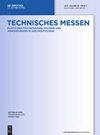Bioanalytical sensors using the heat-transfer method HTM and related techniques
IF 0.7
4区 工程技术
Q4 INSTRUMENTS & INSTRUMENTATION
引用次数: 0
Abstract
Abstract This review provides an overview on bio- and chemosensors based on a thermal transducer platform that monitors the thermal interface resistance R th between a solid chip and the supernatant liquid. The R th parameter responds in a surprisingly strong way to molecular-scale changes at the solid–liquid interface, which can be measured thermometrically, using for instance thermocouples in combination with a controllable heat source. In 2012, the effect was first observed during on-chip denaturation experiments on complementary and mismatched DNA duplexes that differ in their melting temperature. Since then, the concept is addressed as heat-transfer method , in short HTM , and numerous applications of the basic sensing principle were identified. Functionalizing the chip with bioreceptors such as molecularly imprinted polymers makes it possible to detect neurotransmitters, inflammation markers, viruses, and environmental pollutants. In combination with aptamer-type receptors, it is also possible to detect proteins at low concentrations. Changing the receptors to surface-imprinted polymers has opened up new possibilities for quantitative bacterial detection and identification in complex matrices. In receptor-free variants, HTM was successfully used to characterize lipid vesicles and eukaryotic cells (yeast strains, cancer cell lines), the latter showing spontaneous detachment under influence of the temperature gradient inherent to HTM. We will also address modifications to the original HTM technique such as M-HTM, inverted HTM, thermal wave transport analysis TWTA, and the hot-wire principle. The article concludes with an assessment of the possibilities and current limitations of the method, together with a technological forecast.采用热传递法HTM及相关技术的生物分析传感器
本文综述了基于热传感器平台的生物和化学传感器的研究进展,该平台可监测固体芯片与上清液之间的热界面电阻R。第R个参数对固液界面的分子尺度变化做出了令人惊讶的强烈反应,这种变化可以通过温度测量来测量,例如使用热电偶与可控热源相结合。2012年,这种效应首次在芯片上变性实验中被观察到,实验对象是熔化温度不同的互补和错配DNA双链。从那时起,这个概念被称为热传递方法,简称HTM,并确定了许多基本传感原理的应用。用分子印迹聚合物等生物受体使芯片功能化,使检测神经递质、炎症标志物、病毒和环境污染物成为可能。与适体型受体结合,也可以检测低浓度的蛋白质。将受体改变为表面印迹聚合物,为复杂基质中的定量细菌检测和鉴定开辟了新的可能性。在无受体变体中,HTM成功地用于表征脂质囊泡和真核细胞(酵母菌株,癌细胞系),后者在HTM固有的温度梯度影响下表现出自发分离。我们还将讨论对原始HTM技术的修改,如M-HTM,倒HTM,热波输运分析TWTA和热线原理。文章最后对该方法的可能性和目前的局限性进行了评估,并进行了技术预测。
本文章由计算机程序翻译,如有差异,请以英文原文为准。
求助全文
约1分钟内获得全文
求助全文
来源期刊

Tm-Technisches Messen
工程技术-仪器仪表
CiteScore
1.70
自引率
20.00%
发文量
105
审稿时长
6-12 weeks
期刊介绍:
The journal promotes dialogue between the developers of application-oriented sensors, measurement systems, and measurement methods and the manufacturers and measurement technologists who use them.
Topics
The manufacture and characteristics of new sensors for measurement technology in the industrial sector
New measurement methods
Hardware and software based processing and analysis of measurement signals to obtain measurement values
The outcomes of employing new measurement systems and methods.
 求助内容:
求助内容: 应助结果提醒方式:
应助结果提醒方式:


